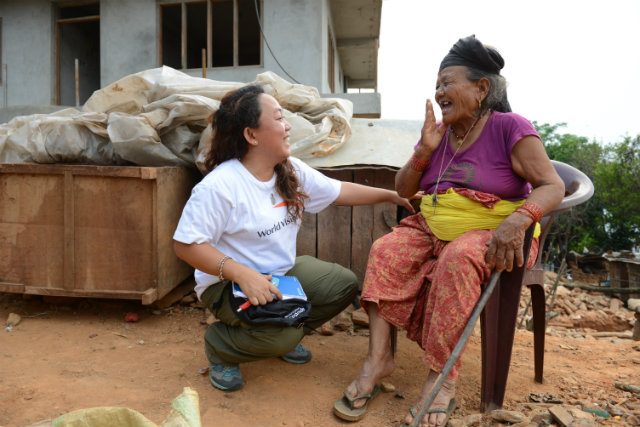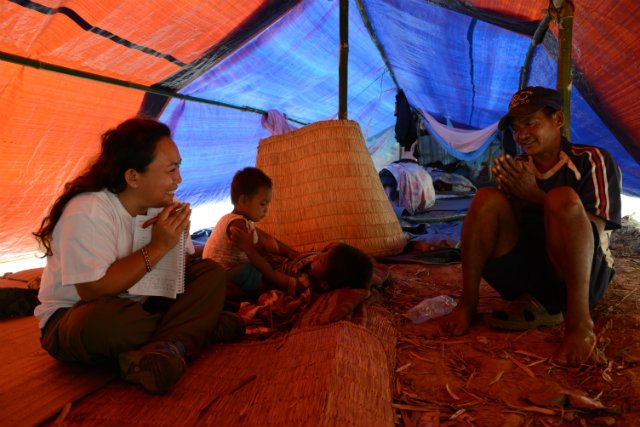SUMMARY
This is AI generated summarization, which may have errors. For context, always refer to the full article.

KATHMANDU, Nepal – I felt violent shaking and I tried to compose myself as I walked fast to the nearest open space. What triggered my fear were the shrill sounds of the crowd in panic – the mad rush and cries of people, including children as they ran out of houses and swaying buildings. Surviving Nepal’s second big earthquake (7.3-magnitude) last Tuesday, May 12, drew me closer to the people we’re trying to help.
News of the Nepal earthquake and its aftermath evoked grave concern. It was personal. This country holds a special place in my heart because my first internationl training was held there in 2011.
When I heard about the April 25 earthquake, all I could think about were the people I met, praying they’re all safe. Days after, I got a call asking if I was ready to be deployed to Nepal. It was an answered prayer to have a chance to help and act. Though I’ve worked in major disasters in my country, responding to the Nepal earthquake was my first international deployment.
Deployment
Working as World Vision’s humanitarian accountability manager for the Nepal Earthquake Emergency Response, it is very important to have avenues for communities to be heard – their vulnerabilities and context understood. Their perspective should be taken into account as we plan and implement programs and activities. I wanted to work closely with the rest of the response team to ensure quality and accountability in the work that we do.
We look at the people’s ability to cope – how they do things on their own and how they seek help. The people’s communication mechanisms – how they prefer to give feedback and engage their government and aid agencies – are as vital as the food and shelter we provide.
One of the first areas I visited were Gorkha and Bhaktapur. I saw the difficulties experienced by quake-hit communities in Paslang, I listened to the people’s voices even if they were distressed. I took note of what people were saying – their urgent needs, the challenges they faced, what information they needed – to uplift the condition of survivors. There was a need to inform people what to do when an earthquake hits and when there are aftershocks.
Livelihood, shelter, comfort
Like Filipinos, education is important to most Nepali families. But children cannot go back to school yet because of damaged buildings. Damaged crops leave farmers with no means of livelihood.
One father said he wants to rebuild a much stronger house. But he wants to know how and where to get the resources. Mothers living under the tarps are grateful they have temporary shelter but they want comfortable and safe spaces for their children, so there is also an urgent need to teach people how to build back better and stronger houses.

Earthquake survivors here in Nepal are afraid and uncertain, distressed and sleepless as they stayed in makeshift tents. There are a lot of questions about where to go for help and what can they do, and who can help them.
People here in Paslang gather together to talk about their experience; it helps them overcome their grief as one community. One young man asked me how he could counsel his fellow community members. That is resilience for me – the same resilience Filipinos have shown as they continue to recover more than a year after the earthquake in Bohol and Typhoon Yolanda.
Talking helps community members express their feelings and start on the road to recovery. They appreciated visits as we spent time to know their needs.
For me we can give people hope as we listen and encourage them to think that something can be done. Though I see pain, I also hear hopeful voices, their sense of family is very evident, their sense of community is strong, and all they need is help to build back their lives.
I bid goodbye to the villagers as I headed back to the meeting with World Vision’s team at Hansapur, ready to share valuable community feedback about what more can be done in that area.
I was standing in front of a collapsed house when an old woman came up to me and held my hand, saying she sees herself in me. I asked her how she was and she started giggling.
“Accha, accha,” she said – good, good. She felt happy that someone took time to stop to talk and listen to her. I gave her a hug. I stand with the people of Nepal. – Rappler.com
Add a comment
How does this make you feel?
There are no comments yet. Add your comment to start the conversation.